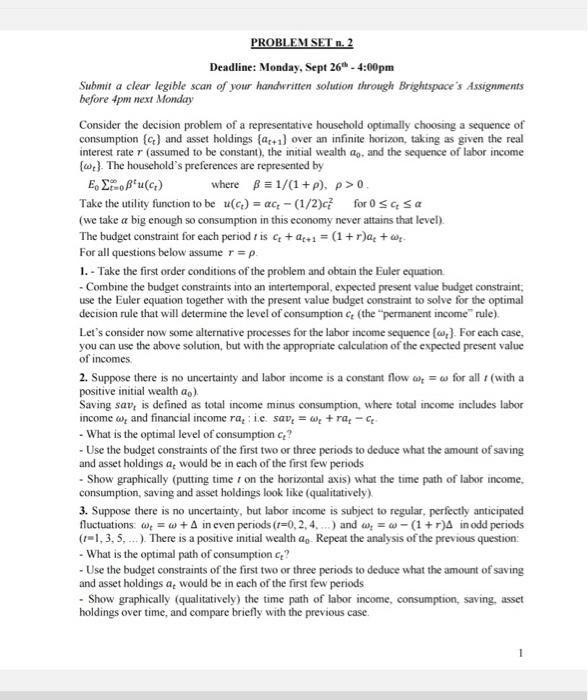Answered step by step
Verified Expert Solution
Question
1 Approved Answer
PROBLEM SET n. 2 Deadline: Monday, Sept 26th - 4:00pm Submit a clear legible scan of your handwritten solution through Brightspace's Assignments before 4pm

PROBLEM SET n. 2 Deadline: Monday, Sept 26th - 4:00pm Submit a clear legible scan of your handwritten solution through Brightspace's Assignments before 4pm next Monday Consider the decision problem of a representative household optimally choosing a sequence of consumption (c) and asset holdings (a+1] over an infinite horizon, taking as given the real interest rate 7 (assumed to be constant), the initial wealth do, and the sequence of labor income (w). The household's preferences are represented by . u(c) where B = 1/(1+p), p>0. Take the utility function to be u(c) = ac,- (1/2)c for 0 qa (we take a big enough so consumption in this economy never attains that level). The budget constraint for each period r is c+a+=(1+r) + w- For all questions below assume r = p. 1.- Take the first order conditions of the problem and obtain the Euler equation. - Combine the budget constraints into an intertemporal, expected present value budget constraint; use the Euler equation together with the present value budget constraint to solve for the optimal decision rule that will determine the level of consumption c, (the "permanent income" rule). Let's consider now some alternative processes for the labor income sequence [w]. For each case, you can use the above solution, but with the appropriate calculation of the expected present value of incomes. 2. Suppose there is no uncertainty and labor income is a constant flow wow for all 1 (with a positive initial wealth a) Saving sav, is defined as total income minus consumption, where total income includes labor income w, and financial income ra, i.e. sav = w + ra-c - What is the optimal level of consumption c? - Use the budget constraints of the first two or three periods to deduce what the amount of saving and asset holdings a, would be in each of the first few periods - Show graphically (putting timer on the horizontal axis) what the time path of labor income, consumption, saving and asset holdings look like (qualitatively). 3. Suppose there is no uncertainty, but labor income is subject to regular, perfectly anticipated fluctuations: w, w+A in even periods (r=0,2,4,...) and w, w-(1+r)A in odd periods (-1,3,5,...). There is a positive initial wealth a,. Repeat the analysis of the previous question: - What is the optimal path of consumption c? - Use the budget constraints of the first two or three periods to deduce what the amount of saving and asset holdings a, would be in each of the first few periods - Show graphically (qualitatively) the time path of labor income, consumption, saving, asset holdings over time, and compare briefly with the previous case.
Step by Step Solution
There are 3 Steps involved in it
Step: 1

Get Instant Access to Expert-Tailored Solutions
See step-by-step solutions with expert insights and AI powered tools for academic success
Step: 2

Step: 3

Ace Your Homework with AI
Get the answers you need in no time with our AI-driven, step-by-step assistance
Get Started


